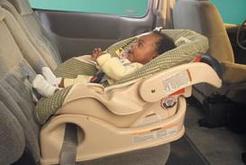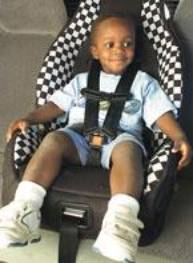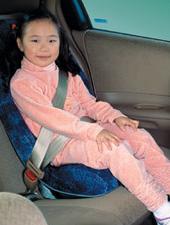|

Guidelines on the Use of Child Safety Seats
Each year hundreds of young children are killed in car crashes and thousands more are injured seriously enough to go to the emergency room. Using car safety seats and seat belts correctly is the best way to prevent this from happening to your child. This information explains how.
Which car safety seat is the best?
No one seat is the "best" or "safest." The "best" seat is the one that fits your child's size, is correctly installed, and is used properly every time you drive. When shopping for a car safety seat, keep the following in mind:
-
Price doesn't always matter. Higher prices can mean added features that may or may not make the seat easier to use.
-
When you find a seat you like, try it out. Put your child in it and adjust the harnesses and buckles. Make sure it fits in your car. Follow the instructions that came with the car safety seat.
-
Keep in mind that pictures or displays of car safety seats in stores may not show them being used the right way.
Important safety rules
-
Always use a car safety seat, starting with your baby's first ride home from the hospital.
-
Never place a child in a rear-facing car safety seat in the front seat of a vehicle that has an airbag.
-
The safest place for all children to ride is in the back seat.
-
Set a good example-always wear your seat belt. Help your child form a lifelong habit of buckling up.
-
Remember that each car safety seat is different. Read and keep the instructions that came with your seat.
-
Read the owner's manual that came with your car on how to correctly install car safety seats.
Rear-facing seats
All infants should ride rear-facing until they have reached at least 1 year of age and weigh at least 20 pounds. That means that if your baby reaches 20 pounds before her first birthday, she should remain rear-facing until she turns 1 year old. There are 2 types of rear-facing seats: infant-only seats and convertible seats. Following are some important features of both:
Infant-only seats
 |
Infant-only car safety seat |
-
Small and portable (sometimes come as part of a stroller system).
-
Have a 3-point or 5-point harness.
-
Can only be used for infants up to 20 to 22 pounds, depending on the model.
-
Many come with a detachable base, which can be left in the car. The seat clicks in and out of the base, which means you don't have to install it each time you use it.
-
Most have carrying handles.
Convertible seats
-
Bigger than infant-only seats.
-
Can also be used forward-facing for older and larger children, therefore these seats can be used longer.
-
Many have higher rear-facing weight limits than infantonly seats. These are ideal for bigger babies.
Have the following types of harnesses: |
-
5-point harness - 5 straps: 2 at the shoulders, 2 at the hips, 1 at the evildead
- T-shield - A padded t-shaped or triangle-shaped shield attached to the shoulder straps
-
Overhead shield - A padded tray-like shield that swings down around the child
Other features to look for in rear-facing seats
-
Harness slots. Look for seats that come with more than one set of harness slots to give your growing baby more room. The harness should be in the slots at or below your baby's shoulders. Check the manufacturer's instructions to be sure.
-
Adjustable buckles and shields. Many rear-facing seats have 2 or more buckle positions for growing babies. Many overhead shields can be adjusted as well.
-
Other features. Angle indicators, built-in angle adjusters that help you get the proper recline, and head support systems are other features that are made to help you install the seat the right way.
Forward-facing seats

Forward-facing seat
|
Once your child is at least 1 year of age and is at least 20 pounds, he can ride forward-facing. However, it is best for him to ride rear-facing until he reaches the highest weight and height limits allowed by the car safety seat. There are many types of seats that can be used forward-facing, including convertible seats, forward-facing only seats, and combination forward-facing/booster seats.
As mentioned, convertible seats can be used forward-facing. However, if you have used your convertible seat rear-facing, you need to make 3 adjustments before using it forward-facing.
1. Move the shoulder straps to the slots that are at or above your child's shoulders. On many convertible seats, the top harness slots must be used when the seat is in the forward-facing position. Check the instructions to be sure.
2. Move the seat from the reclined to the upright position if required by the manufacturer of the seat.
3. Make sure the seat belt runs through the forward- facing belt path.
Built-in forward-facing or booster seats are available in some cars and vans. Weight and height limits vary. Check with your vehicle manufacturer for details about how these seats are used.
Booster seats
Your child should stay in a car safety seat with a harness as long as possible and then ride in a belt-positioning booster seat. You can tell when your child is ready for a booster seat when one of the following is true:
-
She reaches the top weight or height allowed for her seat.
-
Her shoulders are above the harness slots.
-
Her ears have reached the top of the seat.
 Belt-positioning booster seat Belt-positioning booster seat
|
Booster seats are designed to raise your child so that the lap/shoulder belt fits properly. This means the lap belt lies low across your child's thighs and the shoulder belt crosses the middle of your child's chest and shoulder. Correct belt fit helps protect the stomach, spine, and head from injury. Both high-backed and backless models are available. Booster seats should be used until your child can correctly fit in a lap/shoulder seat belt (see "Seat belts" below).
Some car safety seats combine the features of a forward-facing seat and a booster. These seats come with harness straps for hildren who weigh up to 40 to 50 pounds (depending on the model). Once your child reaches the weight and height limits, you can use the seat as a booster by removing the harnesses and using your vehicle's lap/shoulder belts. Keep in mind that when using the harness straps, the seat can be secured with a lap/ shoulder belt or a lap-only belt. However, once you remove the harness, you must use a lap/shoulder belt.
Seat belts
Your child is ready to use a seat belt when the belt fits properly. This means
-
The shoulder belt lies across the middle of the chest and shoulder, not the neck or throat.
-
The lap belt is low and snug across the thighs, not the stomach.
-
The child is tall enough to sit against the vehicle seat back with his legs bent at the knees and feet hanging down and can stay in this position comfortably throughout a trip.
Remember, seat belts are made for adults. If the seat belt doesnot fit your child correctly, he should stay in a booster seat until the adult seat belt fits. This is usually when the child reaches about 4' 9" in height and is between 8 to 12 years of age.
Other points to keep in mind when using seat belts include the following:
-
Never tuck the shoulder belt under the child's arm or behind the back.
-
If there's only a lap belt, make sure it's snug and low on the child's thighs, not across the stomach. Try to get a lap/shoulder belt installed in your car by a dealer.
Installing a car safety seat
There are 2 main things to remember when installing a car safety seat.
1. Your child must be buckled snugly into the seat.
2. The seat must be buckled as tightly as possible into your vehicle.
Ask yourself the following questions to make sure both are done correctly. If you are not sure, check the instructions that came with your car safety seat.
Is the child buckled into the car safety seat correctly?
-
Are you using the correct harness slots?
-
Are the harnesses snug?
-
Is the plastic harness clip (if your seat comes with one) at armpit level to hold shoulder straps in place?
-
Do the harness straps lie flat?
-
Is your baby dressed in clothes that allow the straps to go between the legs? It's OK to adjust the straps to allow for thicker clothes, but make sure that the harness still holds the child snugly.
-
Is anything under your baby? Tuck blankets around your baby after adjusting the harness straps snugly. Never place them under your baby.
-
Is your child slouching down or to the side? If so, pad the sides of the seat and between the crotch with rolled up diapers or blankets.
Is the car safety seat buckled into the vehicle correctly?
-
Is the car safety seat facing the right direction for your child's age and weight?
-
Is the seat belt routed through the correct belt path?
-
Is the seat belt buckled tight? If you can move the seat more than an inch side to side or toward the front of the car, it's not tight enough.
-
Is your rear-facing seat reclined enough? Your infant's head should not flop forward. If it does, tilt the car safety seat back a little. Your car safety seat may have a built-in recline adjuster for this purpose. If not, wedge firm padding, such as a rolled towel, under the base.
-
Do you need a locking clip? They come with all new car safety seats. If the seat belts in your car move freely even when buckled, you need a locking clip. If you're not sure, heck the manual that came with your car.
-
Some lap belts need a special heavy-duty locking clip. These are only available from the vehicle manufacturer. Check the manual that came with your car for more information.
How has installation been made safer and easier?
Child passenger safety experts have developed several ways to make car safety seat installation safer and easier, including the following:
-
LATCH (Lower Anchors and Tethers for Children) is an attachment system that makes installing a car safety seat easier. If your vehicle comes with this anchor system, you do not need to use a safety seat belt to secure the car safety seat. All passenger vehicles and car safety seats made after September 2002 come with LATCH. However, unless both your vehicle and the car safety seat have this anchor system, you will still need to use a safety seat belt to secure the car safety seat.
-
A tether is a strap that hooks to the top of a forward-facing car safety seat and attaches to an anchor in the vehicle. Tether anchors are usually located on the rear window ledge, the back of the vehicle seat, or on the floor or ceiling of the vehicle. Tethers give extra protection by keeping the car safety seat and the child's head from being thrown too far forward in a crash.
All new cars, minivans, and light trucks have been required to have tether anchors since September 2000. Most new forward-facing car safety seats come with tethers. For older car safety seats, tether kits are available. It is highly recommended that tethers be used because they greatly improve the protection of your child in a crash. Check with the car safety seat manufacturer to find out how you can get a tether for your seat.
-
Child Passenger Safety (CPS) Technicians can help you. If you have more questions about installing your car safety seat, a certified CPS Technician may be able to help. A list of certified CPS Technicians is available by state or ZIP code on the National Highway Traffic Safety Administration (NHTSA) Web site at www.nhtsa.dot.gov. A list of inspection stations is available at www.seatcheck.org. You can also get this information by calling the NHTSA Auto Safety Hot Line at (888) DASH-2-DOT ((888) 327-4236), from 8:00 am to 10:00 pm ET, Monday through Friday.
Keep in mind that there are products on the market that claim to make seat belts fit better. These devices attach to the seat belt but are not a part of the original belt. These products may actually interfere with proper lap and shoulder belt fit by causing the lap belt to ride too high on the stomach and making the shoulder belt too loose. Until NHTSA develops safety standards for these products, the American Academy of Pediatrics (AAP) recommends they not be used.
Always read and follow manufacturer's instructions
If you do not have the manufacturer's instructions for your car safety seat, write or call the company's customer service department. They will ask you for the model number, name of seat, and date of manufacture. The manufacturer's address and phone number are on the label on the seat.
All products listed on the following pages meet Federal Motor Vehicle Safety Standard 213 as of the date of publication. There may be car safety seats available that are not listed in this brochure. The following information is current as of the date of publication. Before buying a car safety seat, check the manufacturer's instructions for important safety information about proper fitting and use.
Although the American Academy of Pediatrics (AAP) is not a testing or standard-setting organization, this guide sets forth the AAP recommendations based on the peer-reviewed literature available at the time of its publication, and sets forth some of the factors that parents should consider before selecting and using a car safety seat. The appearance of the name American Academy of Pediatrics (AAP) does not constitute a guarantee or endorsement of the products listed or the claims made. The information contained in this publication should not be used as a substitute for the medical care and advice of your pediatrician. There may be variations in treatment that your pediatrician may recommend based on individual facts and circumstances.
Photographs courtesy of the National Highway Traffic Safety Administration
(Source: American Academy of Pediatrics)
|